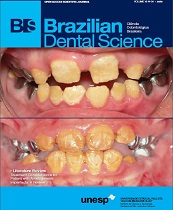Effect of root perforations on the bond strength of fiberglass post using different adhesive systems and resin cement
DOI:
https://doi.org/10.14295/bds.2013.v16i4.940Abstract
Objective: This study evaluated the effect of rootperforations on the bond strength of fiberglassposts cemented to the root canal with two adhesivesystems and resin cement. Material and Methods:Forty single-rooted human teeth received endodontictreatment and were prepared for the cementationof fiberglass posts (Exacto Mini, Angelus). Theteeth were divided into four experimental groups(n = 10) according to the root condition (with orwithout perforation) and the adhesive system used:G1: without perforation + Adper Single Bond 2(3M ESPE), G2: without perforation + Clearfil SEBond (Kuraray), G3: with perforation + AdperSingle Bond 2, G4: with perforation + Clearfil SEBond. The perforation was executed on the rootsurface with a diamond bur and sealed with whitemineral trioxide aggregate (MTA). The specimenswere sectioned and a push-out test was carriedout (1 mm/min speed and 50 kgf). The data werestatistically analyzed by ANOVA and Tukey Test(5%). Results: Adper Single Bond 2 promoted thegreatest values of bond strength to the roots withoutroot perforation. The presence of root perforation ledto the reduction in bond strength values regardlessof the bonding system used (p < 0.05). Conclusion:The root perforations caused a direct effect on thebond strength of the fiberglass posts cemented byreducing the bond strength values to the root dentinregardless of the adhesive system used.
Keywords
Adhesion; Cementation; Dental adhesives; Dental cements; Fiberglass pins.
Downloads
Downloads
Published
How to Cite
Issue
Section
License
Brazilian Dental Science uses the Creative Commons (CC-BY 4.0) license, thus preserving the integrity of articles in an open access environment. The journal allows the author to retain publishing rights without restrictions.
=================




























